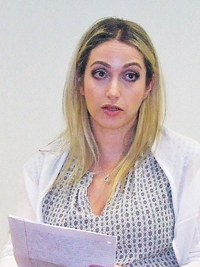
“I didn’t expect such a big turnout,” Dr. Margarita Kogan admitted as she greeted the guests in the library’s Community Room.
St. Luke’s Cornwall Hospital has been sponsoring educational sessions in local libraries. As part of that program, Dr. Kogan was in Cornwall on May 16 to discuss Lyme Disease. Previous sessions had focused on diabetes, heart health and aging eyes.
The response to the hospital’s outreach has been good. But the organizers were still surprised to see 40 people on a Tuesday afternoon. One explanation for the large turnout is the prevalence of the disease.
“It’s increasingly recognized as a major health problem,” Dr. Kogan said. “The number of cases has tripled since 1992. And the number would be higher if every case was diagnosed.”
The presentation was informal. The doctor sat on a table at the front of the room, and invited people to interrupt her with questions. She said that most cases occur from May through July, and the frequency is rising as both the suburbs and the deer population continue to grow.
Deer ticks carry the bacteria, and the Center for Disease Control has said that the tick has to be attached and feeding for a day for the bacteria to be transmitted to a human.
If there’s a tick on you, remove it by its head rather than its feet. People in Dr. Kogan’s office recommend using a Q-tip dabbed in alcohol. They say if you rub the area around the tick, the parasite will eventually come out. Members of the audience suggested using a lint brush.
The disease was named after an outbreak of childhood arthritis in Lyme, Conn. in the 1970s. Arthritis pain, similar to fibromyalgia, is the most common complaint with the disease. In some cases, there may be memory loss and fatigue. The familiar bull’s eye rash normally lasts for three to four weeks, and is often accompanied by symptoms that resemble the flu.
It’s very difficult to diagnose because the bacteria escape detection by hiding in blood cells. You can get the disease more than once. But Dr. Kogan said, “It’s not incurable at any stage.”
By far, the greatest number of cases occur in the Northeast. So it was not surprising that several members of the audience had experience with the disease. Many of them felt comfortable asking questions or sharing experiences.



